BENEFITING FROM THE EXPERIENCES AND TEACHINGS OF PAST MASTERS -- OVERVIEW
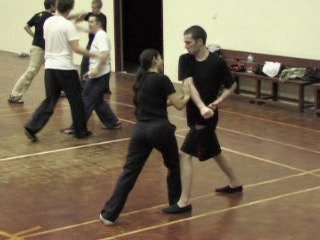
Participants at the Sabah Intensive Shaolin Kungfu Course of March 2007 having a lot of fun practicing the teachings of past masters
When we practice an individualized art like Boxing, we benefit from the experience and teaching of our immediate teachers, and sometimes our teachers' teachers. If a teacher discovers some effective counters against certain attacks, for example, he teaches them to his students. Other practitioners would have to discover these same techniques afresh.
But when we practice an institutionalized art like Shaolin Kungfu, we inherit the experiences and teachings of tens of thousands of masters over many centuries. When we learn some effective counters, these were not discovered or re-discovered by our immediate teachers, or their teachers. The techniques were discovered long ago from direct fighting experience by past masters who incorporated them into the art, and these techniques were refined over time.
An institutionalized art has a repertoire that is unfathomable. Comparing the repertoire of an individualized art built by a few masters over a few years with the repertoire of an institutionalized art evolved by tens of thousands of masters over many centuries is like comparing a drop of water with an ocean.
The experiences and teachings of tens of thousands of masters were refined and generalized into principles. For example, past masters discovered both the concept and the methods that if an opponent was much stronger than you, you needed not match his strength with equal strength. You could use his strength to defeat him. This concept was formalized into a combat principle, poetically described as “Borrowing an opponent's strength to strike him”. Some methods used to implement this principle included striking the weak point of his on-coming attack, like using “Immortal” against “Golden Star”, and “shallowing” his attack and simultaneously striking him, like using “Hand Sweep” against “Precious Duck”.
The Secret of Cross-Road Lock Hand
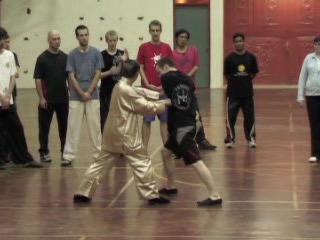
Here is a secret of “Sap Tzi Kow Sau” or “Cross-Road Lock Hand” You can lock both arms of an opponent while striking him. Do you know how to defend against or counter this attack? It is very simple, and it involves a principle which can be very useful in daily life when you are faced with an apparently impossible situation.
Important Conditions when Applying Pressing Attacks
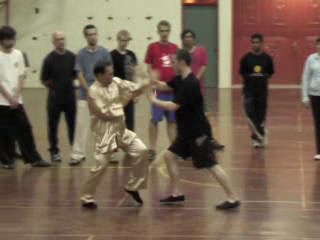
A skillful exponent can easily press an opponent with continuous attacks. Can you remember what the important points are when you use pressing attacks. Most important, you must ensure your own safety. Next, you must be very familiar with the movements you are going to make. This is taken care of by your combat sequences. You must of course have good force, good timing and good spacing.
The Importance of Skills over Techniques
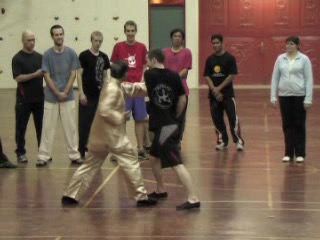
Here is the technique of interception. The impromptu changes are so smooth and spontaneous that many people may not notice them. This requires much skill. You can also notice Sifu Jamie smiling away, perhaps at the fun of being overwhelmed by Grandmaster Wong, or perhaps at the opportunity of learning a new skill. Having fun is a constant feature in our Shaolin Wahnam training.
The Profundity of Simple Movements
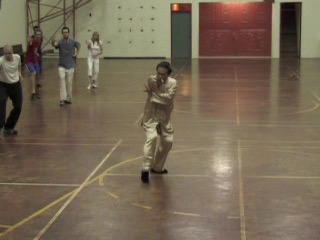
Shaolin kungfu movements are simple, but there is much profundity in the simplicity. An example is found in this video clip. You have performed these movements many times, especially after Combat Sequence 5 onwards. Did you know that herein lies the secret of interception?
The Importance of “Shen” or Spirit
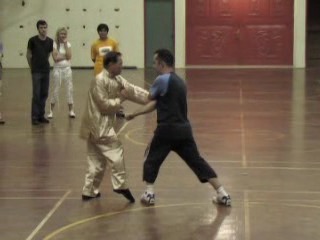
Merely knowing the counters is insufficient in good kungfu combat. You must have “shen”, or spirit. Grandmaster Wong demonstrates the response of a practitioner without much “shen”. “Shen” or spirit is present in the second example. Notice that Andy almost succeeds in breaking through Grandmaster Wong's first “closure”, but Grandmaster Wong “tames” him again, so smoothly and spontaneously that many people may not notice.
Adjusting Footwork for Right Spacing

Right spacing is important in intercepting and counter-striking. In the first example, Grandmaster Wong steps forward as he counter-strikes. In the second example, as George has moved quite close, Grandmaster Wong retreats his back leg as he strikes. This is an example of of the tactic in “using retreat as advance”.
The Amazing Tiger Claw Technique
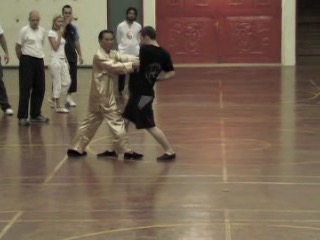
When your opponent uses the Tiger Claw to initiate a pressing attack, you can use the same technique of the Tiger Claw to “close” him and counter-strike. Sifu Jamie opens Grandmaster Wong's Tiger Claw defence with a Tiger Claw and is about to press in with continuous attacks. Grandmaster Wong uses the same Tiger Claw technique to intercept and counter-attack. After that, Grandmaster Wong shows the mechanics of the Tiger Claw technique.
Helping One Another in Shaolin Wahnam Training

The opening, closing or intercepting technique of the Tiger Claw in “Single Tiger Emerges from Cave” is similar to the threading technique of the Dragon Hand Form in “Golden Dragon Plays with Water”. This video clip shows Sifu Jamie helping Bernadette with the Dragon technique. Helping one another is an important aspect of our Shaolin Wahnam training.
LINKS
Review of the Intensive Shaolin Kungfu Course in Sabah in March 2007
- Overview 1 : The Fundamentals
- Overview 2 : The 16 Combat Sequences
- Overview 3 : Are They Performing Kungfu Dance?
- The Basics of Shaolin Kungfu Training
- Fundamental Combat Skills
- Defeat you Hand to your Opponent, Victory you Create Yourself
- Avoiding Disadvantages and Seeking Advantages
- Basic Principles and Tactics of Combat
- Skills derived from Sparring can be Rewardingly used in Daily Life
- Some Secrets in Practicing Genuine Kungfu
-
Various Ways to Move into an Opponent
- Applying Combat Sequences in Sparring
- Linking Sequences to be More Combat Efficient
- The Secrets of Continuous Cannons
- The Mechanics of Continuation
- Marvelous Techniques Beget Marvelous Techniques
- Perfecting Forms and Developing Force
- Applying Tactics in Combat
-
Objectives of Form Training in Solo
- Being Fluent in Kicking Techniques before Applying them in Combat
- Using Tactics in Kicking Attacks and Defences
- Different Levels of Sophistication in Sparring and Fighting
- The Legacy of Uncle Righteousness: Secret of Continuous Cannons and their Counters
-
Benefiting from the Experiences and Teachings of Past Masters
- Poetic Patterns Can be Very Deadly
- Moving Back One Step when in Diffiuclt Situations
- Linking Sequences to Form a Kungfu Set
- Felling Techniques in Kungfu are Different from Judo and Wrestling
- Butterfly Palms and Hiding Flowers are Excellent in Countering Felling and Gripping Attacks
-
Let Mercy Flow from the Hands
- Benefits of Solo Set Practice — Combat Sequences 13 to 16
- From Pre-Choice Sequences to Free Sparring
- Applying Shaolin Patterns Correctly and Spontaneously in Free Sparring
- Shaolin Kungfu against Boxing and Kick-Boxing
- Shaolin Counters against Wrestling Shoots
- The Secret of Grandmaster Ho Fatt Nam
- Why Shaolin Kungfu is Technically Faster than Boxing
- Shaolin Techniques, Tactics and Strategies against Boxing
- Revealing Secrets of Past Taijiquan Masters
- Overwhelming Opponents with Just One Pattern
- Poetry and Elegance in Effective Combat
